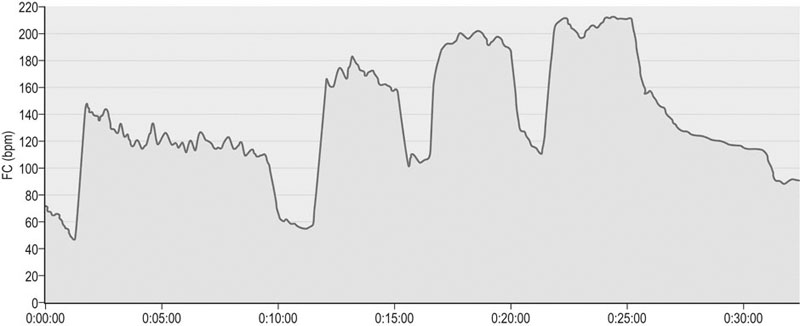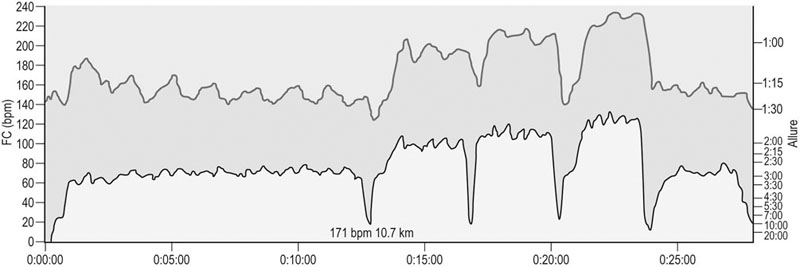Most of the past publications on exercise physiology or poor performance relate to treadmill exercise testing. Although these studies have provided valuable information on the physiology of exercise and exercise-related pathological processes, treadmill exercise testing can be difficult to integrate into the management of an athletic horse. The use of a treadmill requires that the horse be transported to a facility with appropriate equipment. The necessary equipment is expensive to setup (e.g. purchase of a treadmill) and run given that a dedicated team of several experienced people is required for each test. Consequently, treadmill laboratories are usually limited to research facilities or large referral clinics. The use of a treadmill also may be wrongly perceived as dangerous. However, a recent multi-centered retrospective study has shown that the prevalence of treadmill-related accidents or injuries is low.1 The arguments for using high-speed treadmills to evaluate fitness and health of horses are obvious. The physical environment can be controlled, and the conduct of exercise tests with precise design is possible. The speeds and durations of each step of an exercise test are highly repeatable. There is also easy access to the horse at suitable times during and after exercise for cardiorespiratory measurements and blood collections. The necessity for an acclimation of horses prior to clinical exercise testing on a treadmill has been debated. Some performance testing laboratories do not acclimatize horses and others may apply up to three acclimation runs prior to testing.2 Responses to acclimation runs are unpredictable in individual horses. Figure 3.1 illustrates the variability of HR and plasma lactate concentrations during treadmill exercise in horses that were given four treadmill tests on consecutive days. Several studies have shown that physiologic responses to treadmill exercise do not replicate responses to field exercise. HR and plasma lactate concentrations in Standardbred horses pulling a 10 kilopond draught load were lower on the treadmill than on the racetrack.3 It was also reported that HR and blood lactate in trotters were lower during exercise on a level treadmill than during exercise on a racetrack (Fig. 3.2).4 HR were expressed as V200, the velocities (V) at which HR reached 200 beats per minute. Blood lactates were expressed as V4, the velocity at which blood lactate was 4 mmol/L. This value is sometimes referred to as VLA4. Stride frequency was lower and stride length was greater on the treadmill. Interestingly, this study also showed that there were no differences in any measurements on two sand tracks of 720 and 1250 m in length. A study of ridden Warmblood horses also found that HR and blood lactate concentrations were lower on a level treadmill at speeds of 6.5–9.4 m/s compared with exercise over ground.5 The treadmill speed had to be increased by approximately 10% or the treadmill incline increased to 1–2% to elicit that same HR response observed in the field. Similar findings were found for HR and derived indices (V160 and V200) in endurance horses examined both on a racetrack and on a treadmill.6 Locomotion during treadmill exercise is quite different to that on the track. As a consequence, even if horses are given tasks on treadmills that produce similar HRs, their gaits may be quite dissimilar. Stride frequencies at identical trot and gallop speeds are greater on a racetrack.7 Design of treadmill exercise tests to replicate field exercise therefore seems to be a fruitless endeavor. An exercise test typically consists of several bouts of exercise after a warm-up, which may or may not be separated by a period of recovery. HR and V are usually measured during the exercise and blood samples may be collected following each step of the exercise test. Numerous testing procedures have been described for horses involved in different disciplines. Regardless of the discipline, field exercise test protocols should always be strictly defined in order to calculate meaningful fitness measurements and to limit variability (Box 3.1). Following standardized procedures is of great importance as the data derived from each test can be compared to subsequent tests for the same horse or with measurements from other horses of similar age and training status. Results may vary according to the methodology used and with factors such as number and duration of steps, resting time between steps and the degree of increment from one step to the next. From the measured variables, HR, V and blood lactate concentration, derived parameters can be calculated to allow a comparison between the results of successive tests. HRs are usually expressed relative to a constant submaximal speed, such as V200, the velocity at which heart rate is 200 bpm. However, expression of the V at lower HR is equally valid and some studies have used V140 and V170, although at such speeds, HR may be more markedly influenced by stress and vagal tone. To compare blood lactate values between horses, the V at a blood lactate concentration of 4 mmol/l (VLA4) has generally been used.9,11,13–16 VLA4 is considered as a reference value for horses as it is a good predictor of aerobic capacity. A high value for VLA4 is an indication of a superior exercise capacity and is related to racing performance17–20 As the horse increases fitness, VLA4 increases. The data obtained during an exercise test can be used to address several questions related to the fitness and performance capacity of a horse (Box 3.2). Ideally, measurement of HR, VO2, and pulmonary ventilation is necessary to answer all of these questions. Nonetheless, blood lactate and HR measurements during or after suitable exercise tests can help with answers to questions 2–5 in Box 3.2. In the following sections, field exercise tests that have used HR and blood lactate measurements in a range of different disciplines will be described. 1. warm-up routine prior to testing 2. rates and distances of acceleration during the exercise 5. time after exercise at which blood is collected Environmental conditions are an important consideration during field exercise testing.21 HR and other variables were compared under high and low ambient temperature and relative humidity during a submaximal incremental field exercise test in horses tested in summer and in autumn. HR was measured continuously, the other variables at rest and immediately after 4 minutes of running at 3.5, 4.5 and 7.0 m/s, separated by three minute rest intervals, and after five and 10 minutes recovery. HR was significantly greater by a mean of 13 beats per minute during exercise in the hot versus cool conditions. It was concluded that differences in environmental conditions can affect assessment of exercise response. These factors must be considered when using fitness tests in the field. Sudden changes in environmental conditions might have considerable consequences for HR and blood lactate responses during exercise. The type and quality of a track is another consideration as track conditions have been shown to influence physiological variables measured and calculated during a standardized test.16 Telemetric electrocardiography was used widely in the 1960s and 1970s to study the HR and ECG of racehorses during exercise on racetracks.22–27 Direct recording of the ECG with an on-board tape recorder was also used to assess HR during races.28 These studies described typical HR responses during submaximal and maximal exercise in Thoroughbreds and Standardbreds. Studies of HR were also combined with telemetry of arterial blood pressure at speeds up to 800 m/min.29 These studies were mostly descriptive, and did not focus on the design of the exercise tests. The HR response to exercise is easily measured by means of electrodes placed in a thoracic girth strap (Polar, Finland) (Fig. 3.3) which is then placed under the saddle (Fig. 3.4). A coded and wireless transmitter placed on the girth transmits data to the HR meter which is either worn by the rider or placed on the saddle or on the sulky. Most of the heart rate meters record HR continuously and enable transfer of the data to a computer for analysis as shown in Figure 3.5 and Figure 3.6, which depict HR during exercise in two trotters. The exercise test consisted of three steps of 3 min at speeds of approximately 500, 580 and 660 m/min, with a brief period of walking between each step. When HR and V velocity are measured simultaneously (Fig. 3.6), it is possible to create a graph of the HR vs. speed relationship as shown in Figure 3.7. The graph also enables calculation of V200. The HR response to exercise is linear between 120 and 210 bpm. Several factors can affect the HR/speed relationship including the geometry and length of the track, environmental conditions, training state10,12,30 and disease31–39 as well as the level of excitement.36 However, the regression of HR to speed is repeatable when measured during standardized exercise.8 In general, an increase in fitness results in an increase in V200 while loss of fitness, stress, cardiovascular and respiratory disease, lameness, and an increase in bodyweight could all cause a decrease in V200.31–39 These factors should be considered when interpreting V200 values. Box 3.3 summarizes factors that may contribute to a higher than expected HR during submaximal exercise. In an excitable state, the slope of the regression line of HR on velocity is decreased because of high HRs during trotting.36 V200 was thus falsely high. This finding emphasizes the need for careful observation of horses during field exercise tests, and for questioning of trainers and jockeys concerning the emotional state of the horse during exercise. If in doubt, calculation of V200 should be delayed until the horse has completed a test in a relaxed state. The correlation between 31 values of V200 measured on two consecutive days was 0.88.36 The differences in V200 were in the range of 0–50 m/min. Precision of V200 measurements in the field would probably be increased by use of more than one exercise test, and inspection of scatter plots to discard obvious outliers. Figure 3.8 shows the effect of excitability on heart rates during trotting, and the effect on V200. High HRs in this study36 were also associated with gait changes that were not ‘smooth’, and with phases of rapid acceleration. V200 is also influenced by track type, with lower values on sand tracks than on grass or wood-chip surfaces. Interestingly, the V200 was not significantly different in horses ridden by light (55 kg) and heavy (70 kg) jockeys in a crossover study.36 However, the mean V200 was 35 m/min higher with light jockeys, and it seems sensible to avoid large differences in rider weight when evaluating a horse in repeated tests over time. Age and training state also influence V200. In trotters, V200 was higher (641 ± 35 m/min) in horses aged six years or more when compared to horses aged 17 months (498 ± 39 m/min). The effects of growth and maturation as well as physical conditioning likely accounted for this difference in V200. In two-year-old Thoroughbred horses, mean V200 increased by approximately 65 m/min (10%) over a five-month training period (Fig. 3.9).36 In French trotters, V200 increased with training over a six-month period. In two-year-old horses, the average increase in V200 was 40 m/min, while in horses above four years of age, the average increase in V200 was approximately 20 m/min.12 Telemetric ECG was first used in the 1960s, although wider clinical application during field exercise testing has only occurred during the last 10 years.40–42 ECG measurement during a standardized exercise test is important for evaluation of poor performance because disturbances in cardiac rhythm may only manifest during exercise.43 Previous studies have documented ECG responses to different types of exercise in clinically normal horses with no performance problems; review of these data is helpful for interpretation of ECG data in clinical cases.40–42 Blood lactate concentration may be measured in blood samples obtained at the end of the exercise period; samples are typically taken from a jugular vein and should be collected into tubes containing fluoride-oxalate as anticoagulant. Lactate is a product of muscular metabolism and accumulates in muscle and blood at high intensities of exercise. The concept of anaerobic threshold, extrapolated from the plotted curve of blood lactate concentration against speed, has been defined as the level of work just below that which results in the accumulation of lactate in blood.44 The aerobic-anaerobic transition or onset of blood lactate accumulation (OBLA) has been defined empirically as 4 mmol/l blood lactate concentration. Several factors, including the site of sample collection (e.g. venous vs. arterial), type of sample analyzed (whole blood vs. plasma), and method of sample preparation (e.g. addition of perchloric acid to the sample) will affect lactate concentrations and derived parameters such as VLA4 and VLA10.45–49 Blood lactate is transported in plasma and RBC; the lactate concentration in whole blood is lower when compared to plasma due to the sequestration of some of the total lactate within RBC. Several rapid analysis/analyzer systems have been used for measurement of lactate in equine whole blood or plasma. One of the authors (ACM) has compared lactate measurements by the Accutrend Lactate, Ektachem and Boerhinger enzymatic techniques (n = 55 samples). In whole blood samples deproteinized by the addition of perchlotic acid, results obtained with the Accutrend were significantly higher (1.05 mmol/l ± 0.92) when compared to the Boehringer method. For plasma, there was no significant difference between measurements done with the Ektachem and the Accutrend. In another study, analysis with the Yellow Springs Instruments 2300 Stat Plus was found to be reliable for measurement of plasma lactate from 0–30 mmol/l. However, the TDx Lactic Acid Assay was deemed to be unsuitable for use with equine plasma due to greater variability in measurements.50 The VLA4 has been widely used to compare blood lactate responses between horses or in the same horse over time. Several studies have demonstrated a negative association between blood lactate responses and measures of racing performance. Evans et al17 measured blood lactate in Thoroughbred horses at 2 and 5 min after an 800 m gallop and also during a submaximal exercise test on a 5% inclined treadmill, with results compared to retrospective racing performance as indicated by Timeform ratings. Blood lactate concentrations 2 and 5 min after treadmill exercise were significantly correlated (r = −0.68, P < 0.01) with Timeform.17 In a small (n = 7) group of Swedish trotters, the first two horses to begin their racing career were the ones that had the lowest lactate concentration after submaximal tests. Leleu et al18,20 showed that the VLA4 of good performing French trotters was significantly higher than in intermediate or poor performer horses.20 An increase in fitness results in an increase in VLA4. Loss of fitness, stress, respiratory disease and an increase in bodyweight could all cause a decrease in VLA4.31–35 All these factors should be taken into account when interpreting individual values. The results of a study that measured VLA4 in 194 trotters that performed a total of 1105 standardized exercise tests on a sand racing track are presented in Table 3.1.12 Growth and development, as well as physical conditioning, appears to influence VLA4. In two-year-old French trotters trained for six months, the mean increase in VLA4 was approximately 45 m/min, whereas in four-year-olds the average increase in VLA4 was 30 m/min.12 Table 3.1 VLA4, the velocity at which blood lactate concentration reaches 4 mmol/L, expressed in m/min according to age in 194 trotters that performed a total of 1105 standardized exercise tests on a sand racing track, 1250 m long12 Underlying respiratory problems (upper airway disorders such as laryngeal hemiplegia as well as lower respiratory airway diseases such as inflammatory airway disease and/or exercise induces pulmonary hemorrhage) can limit oxygen exchange and may explain a higher than expected blood lactate concentration during exercise and thus a low VLA4.51 Total red cell volume (RCV) is a major determinant of oxygen-carrying capacity. In horses, RCV has been measured by the Evans Blue dye dilution method when applied following mobilization of the splenic erythrocyte pool.52,53 Total RCV relative to bodyweight was significantly correlated with maximal trotting speed over 1000 m in 35 Swedish trotters (r = 0.68, P < 0.001).54 These results suggest that this measurement may be useful for assessment of performance capacity. However, measurement of total RCV by the dye dilution technique is not a simple procedure and cannot be readily applied in veterinary practice. Hematocrit after maximal exercise, which ranges from 60 to 70%, was not correlated with Timeform rating in English Thoroughbreds17 and does not appear to be valid measure of fitness or performance capacity. However, the hematocrit can be measured after maximal exercise if results of resting hematology suggest that a horse is anemic. Values should exceed 55% immediately after maximal exercise in trained Thoroughbreds. In Standardbred race horses, overtraining was associated with a decrease in PCV measured after a 2400 meter time trial at maximal speed. Mean values were 56% in control horses and 52% in overtrained horses.55 Total RCV did not decrease during overtraining, so the decrease in hematocrit may have reflected the decrease in velocity of the horses during the time trial rather than a true decrease in the oxygen carrying capacity. A treadmill study also found that onset of overtraining was not associated with alterations in RCV.56 Oxygen consumption or uptake (VO2) describes the rate of oxygen use in liters per minute, and is usually expressed relative to body mass. In human exercise physiology, the current gold standard for evaluating aerobic capacity is the measurement of the maximum rate of oxygen consumption (VO2max). The VO2max parameter integrates the efficiency and coordination between respiratory, cardiovascular and neuromuscular systems and thus yields both physiologic and metabolic information.57 Measurements of VO2max can be used to predict aerobic power and endurance performance in untrained human subjects. It is primarily limited by the maximal HR and cardiac stroke volume during exercise. A cardiac limit to performance can be best evaluated by measurement of oxygen pulse, the volume of oxygen ejected with each ventricular contraction. This measurement necessitates simultaneous measurement of VO2 and HR during exercise. Rates of oxygen uptake during submaximal exercise will depend on gait, economy of locomotion, body mass, and other factors.
Exercise testing in the field
Limitations of treadmill exercise testing
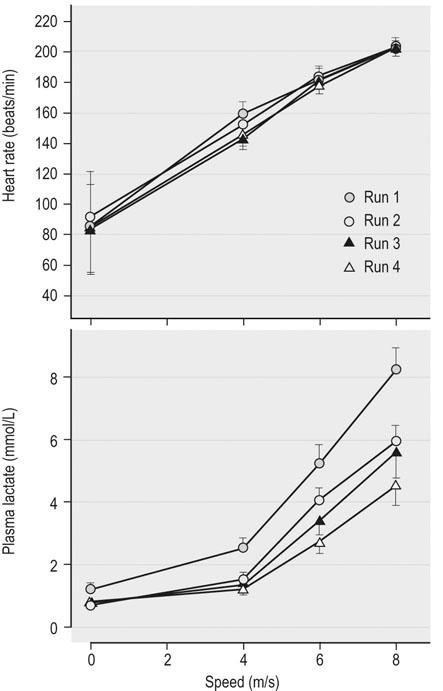
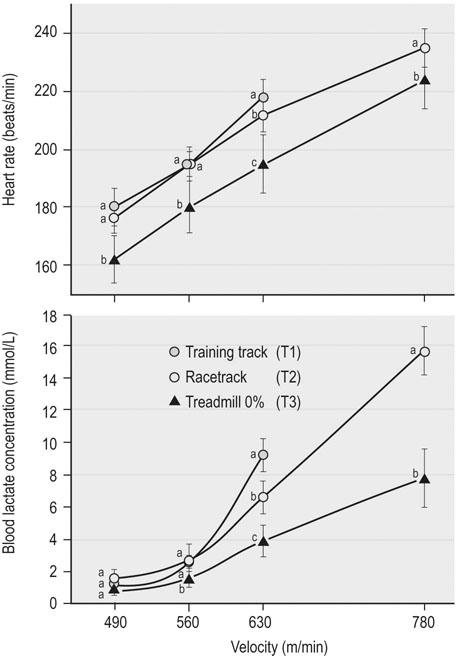
Field exercise tests
Measurements during field exercise tests
Heart rate
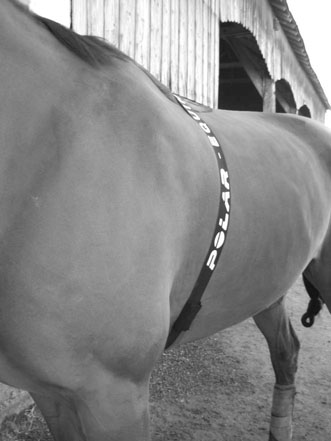
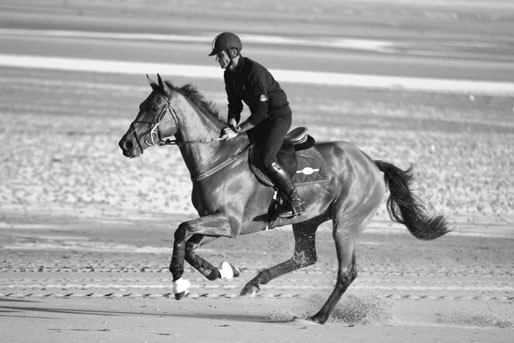
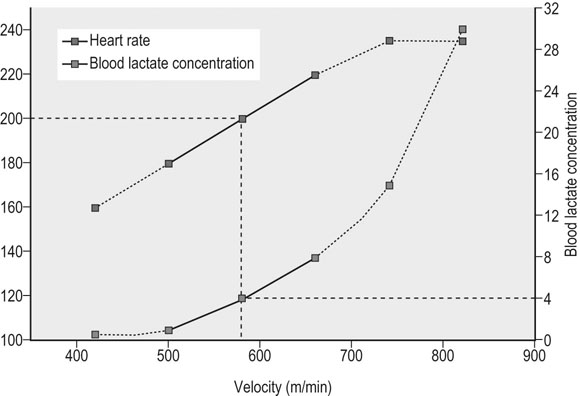
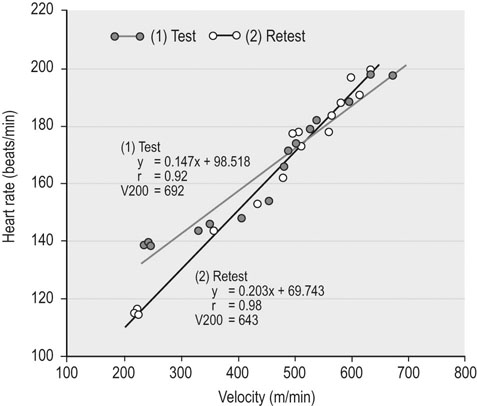
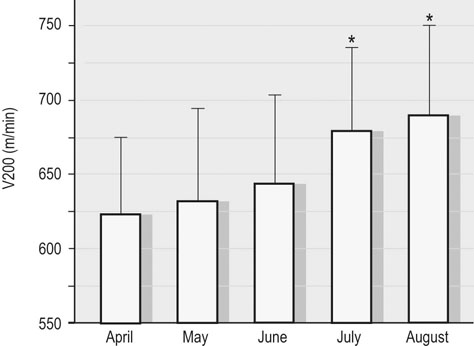
Electrocardiography
Blood or plasma lactate
AGE
MEAN VLA4 (EXPRESSED IN M/MIN) (±SD)
1
512 ± 21
2
551 ± 29
3
590 ± 41
4
611 ± 26
5
616 ± 26
6
626 ± 30
Red cell volume and hematocrit
Measurement of oxygen consumption in field exercise
![]()
Stay updated, free articles. Join our Telegram channel

Full access? Get Clinical Tree


Exercise testing in the field

